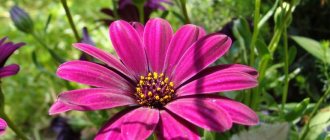Lilies are beautiful flowers, with an incredible aroma, which with their presence will transform the most modest flowerbed. There are many varieties and varieties of the plant that can amaze with different colors and petal patterns. There are garden and indoor lilies, perennial and annual, frost-resistant and those that can only be grown in the southern regions.
Everyone knows what a lily flower looks like; it has a unique appearance.
General description, flower characteristics
Lily is a herbaceous, bulbous plant. The height of the bushes, the timing of flowering and the color of the lily depend on the characteristics of a particular species.
Lily family Liliaceae, class Monocots. Latin name Lilium L.
In nature, there are more than 100 different plant species, native to North America and Asia.
The typical flower species is Lilium candidum or snow white.
The size of the bush varies depending on the type of plant. These can be small compact bushes no more than 30 cm high, or loose flowers up to 1.5 m high.
Description of bulbs, roots
There are two types of bulbs - scaly and bare. Shape: ovoid or round. They consist of several lobes that are located close to each other. The size of the bulbs is 1-30 cm.
The roots are thin, white, grow in a bunch, extending from the bulbous bottom.
Stem and leaves
The stem is straight, green. Length varies from 30 cm to 1.5 m.
The leaf blades are sessile, petioles are absent. The shape is linear-lanceolate. The average width is about 2 cm, length 20 cm.
Some species have aerial bulbs (bulbs) in the leaf axils, which are used in propagation.
What is common to all types of plants is the number of petals, but their shape, color, and presence of inclusions vary
Flowers, petals, seeds
How many petals does a lily have? There are 6 of them, each of which is separate. The color and shape are varied, depending on the species.
The shape can be straight, or curved at the end, cup-shaped, funnel-shaped or drooping.
The fruit of the lily is represented by a hexagonal cylindrical box, which bursts when fully ripe. The seeds are translucent, flat in shape.
Aroma
The smell of these flowers varies depending on the type and variety:
- strongly expressed suffocating;
- subtle;
- may be completely absent.
The field lily or saranka grows in the Crimea, the Caucasus and Southern Europe
Rules of care
This flower does not require care. It needs to be watered on time and weeds removed. During intensive growth, lilies need a lot of moisture. However, you should try not to flood the plant, as it does not like excessive dampness. On hot summer days, watering is carried out in the morning and evening hours, and it is recommended to mulch the soil so that it does not dry out very quickly.
The first feeding is carried out in the spring after the shoots appear. When flowering begins, lilies are fed with phosphorus-potassium fertilizer. The fertilizers needed for fertilizing can be purchased at a specialized store.
Often, hybrid oriental lilies tolerate winter very poorly. It is recommended to cover such a flower in rainy weather, this will prevent the soil from getting too wet and the development of rot on the bulbs. Lilies need to be ventilated only when the sun is shining.
Lack of flowering may be a consequence of deep planting. The rapid wilting of flowers is associated with overheating of the soil. In this case, its surface must be mulched.
Only one pest can appear on a plant - the lily beetle. It is recommended to collect it manually. The fact is that chemical treatment can significantly spoil the appearance of foliage.
When the lily fades, you need to wait a while and only then collect the seeds. Watering is carried out until late autumn or before transplantation.
Bulbs must be stored correctly. So, the bulbs should be cleaned from the soil and dried.
Varieties and varieties
Varieties of lilies and their popular representatives:
- Asian are hybrids. They have strong immunity and are resistant to cold. The main colors are pink, white, yellow, burgundy. There is no smell.
- Martagon - has petals of an unusual, curly shape. The aroma is pleasant.
- Candidum - this type includes flowers painted white or milky. Candidum are capricious and require special care.
- American - two-color petals with various inclusions. The aroma is light. They are picky about the climate and have difficulty with transplanting.
- Long-flowered - tubular-shaped flowers, the color is predominantly white, the aroma is strong.
- Orleans and trumpet - flowers have a star or goblet shape. Common colors are red, pink and yellow.
- Oriental - characterized by different shades of petals. A distinctive feature is a yellow stripe that runs down the middle of each petal.
To divide into species, the growing conditions, the structure of the bulbs and seeds, and the shape of the inflorescence were taken into account.
Of all the varieties, the most recognizable are the eastern representatives of the plant, in which the color of the petals, although different, remains common, but the dividing stripe remains
What a lily looks like depends on its variety. The most popular and most sought after plants among gardeners:
- Lollipop - the petals are painted in two shades, there are speckles;
- Mystery Dream is a lily with an unusual color - the main color is light green with burgundy streaks;
- Lady Alice - flowers of a golden hue, tall bush, up to 150 cm;
- Purple Lady - yellow petals combined with purple stamens;
- Lavon - the height of the bush reaches 180 cm, the diameter of the flowers is 30 cm, the color is golden with a cherry stripe;
- Carmen is an unusual lily with thin, pointed petals of a rich ruby color.
Breeders regularly develop new varietal varieties of flowers, which are registered by the Royal Horticultural Society.
Landing algorithm
Bulbs are grounded in spring or fall. These times of year are traditionally considered the right time for planting or transplanting as they begin a new cycle of plant growth.
Planting involves following step-by-step instructions:
- A soil layer is poured into the pot on top of the drainage layer.
- The onion is placed in the center of the container. The voids between the bulb and the walls of the pot are filled with soil and lightly patted down.
- The soil surface is watered.
Transplantation of an adult plant is carried out according to the same scheme, but it is taken into account that the leaves may disintegrate after the bulbs are freed from the soil. To prevent this from happening, the leaves are tied in advance with strong twine. Adult plants are transplanted into a larger pot using the transshipment method. This means that the bulbs are moved to a new container with an old lump of earth.
Classification
Garden lily flowers have the following classification:
- Varietal or hybrids are flowers that are grown by gardeners. They are bred through selection, have a wide variety of colors, and are resistant to frost. A distinctive characteristic is the muted strength of the aroma.
- Wild or species - cultivated in botanical gardens and greenhouses. Growing them yourself is very difficult. There are about 16 wild species that have different colors and patterns on the petals.
Wild lilies have a very strong aroma, which can cause negative reactions in sensitive people: from headaches to real allergies and suffocation. Allergy sufferers should not live near such flowers.
One of the most popular wild representatives is the Leopard lily.
Asian hybrids
Below in the article, we talk in more detail about the varieties themselves, which were presented above with additions in the form of photos of lily flowers. First of all, we will consider Asian hybrids, which represent the most numerous group. Once upon a time, it was the varieties of this variety that were used to obtain other types. As can be understood from the name, their main place of growth was originally Asia.
Even just looking at a photo of Asian hybrid lily flowers, you can clearly understand that there are a huge variety of varieties and colors of the buds of this plant. This includes a wide variety of varieties not only in size (from small bushes up to 40 cm high to giants reaching up to one and a half meters), but also in color. It seems as if the entire gamut of colors from white to black was absorbed in order to color the flowers in various shades. Moreover, often the coloring is not only monochromatic, but also contains several colors or additions in the form of multi-colored strokes or spots. The only exception for Asian hybrids is the absence of colors in the blue or blue spectrum.
If you are wondering what a lily flower of this variety looks like, then it is impossible to answer it unequivocally. Flowers may well have a wide variety of shapes, and sometimes even double buds are found among them. Their diameter is not very large for these plants - from ten to fifteen centimeters. They usually bloom from the first days of June to mid-August, but, unfortunately, they fade very quickly, so you won’t be able to admire them for more than a couple of weeks. In fact, most gardeners in Russia prefer to choose these varieties because they are unpretentious and can grow even in the Siberian region.
Features of growing garden varieties
When it is known what types of lilies there are, novice gardeners are faced with the question of how to grow certain varieties of flowers. When planting, all types of plants have the same requirements for choosing a location:
- nutritious and light soil;
- an area with abundant but diffuse lighting, which should not be exposed to direct sunlight during the day;
- the presence of drainage so that there is no stagnation of moisture after heavy rainfall or watering;
- absence of drafts and protection from strong winds.
Neutral soil is suitable for lilies. Some species prefer acidified or slightly alkaline soil.
Certain types of plants can be grown indoors in pots; their life indoors and the necessary agrotechnical measures are not much different from their outdoor counterparts.
Some varieties are suitable for home growing
To ensure the active formation of lily buds, it is necessary to observe a number of agrotechnical measures:
- the first year after planting, there is no need to apply fertilizer in the spring;
- replenishments are used once per season, provided that fertilizers were applied during planting;
- garter of tall plants;
- trimming the buds after they have completely faded.
The dates for planting in open soil are spring and early autumn with stable, warm weather.
Features of cultivation:
- watering - regular, moderate, carried out as the top layer of soil dries out;
- loosening and mulching - after each watering, pine chips or peat are used for mulch;
- fertilization;
- covering plants for the winter using pine branches or mulch;
- autumn pruning of completely dried stems.
When watering, water is poured strictly under the root; it is important to avoid getting moisture on the green part and buds.
Plants are replanted once every 3-5 years. The need to change the place for the lily will be indicated by such signs as a decrease in the number of buds and their size, or the bush completely stops blooming.
During a winter with little snow, even frost-resistant bushes need to be covered; without a thick layer of snow covering, the bulbs may not be able to withstand extreme cold.
Shelter for the winter
How to plant lilies
It should be remembered that the lily has an extremely negative attitude towards the transplantation procedure. In this regard, it is recommended to grow it without transplanting for several years.
It is also necessary to take into account other nuances:
- A fairly well-lit place, protected from strong gusts of wind, is suitable for planting lilies.
- The most suitable soil for this type of plant should be loose, well-drained and rich in nutrients.
- In order for the flowers to grow better and hurt less, about 4 weeks before they are planted, you need to add ash to the soil and dig everything thoroughly.
- Humus and peat and other mineral fertilizers, which can be purchased at a specialized store, are also suitable for fertilizing the soil.
When choosing a lily bulb in a flower shop, you definitely need to find out exactly what species this plant is related to. The fact is that the care features of different types of lilies are somewhat different.
You should opt for the strongest onions, on the surface of which there are no signs of damage or rot. It is worth considering that the minimum root length for bulbs of these colors is 5 cm.
Deadlines
Lily bulbs need to be planted in autumn or spring; in some cases, this procedure can be carried out in the summer. Planting in spring is a fairly popular option. In this case, the bulb will be able to take root well, become stronger and not freeze during wintering.
But experts still advise planting lilies in the autumn. The roots have time to set even before the first frost. However, the grower should take all necessary measures for the successful wintering of the bulbs. Planting of such flowers is usually done in the first autumn month. But at this time, the gardener may have difficulty purchasing high-quality bulbs. During this period, you can replant the lilies available on the site.
Planting scheme
It should be remembered that it is necessary to plant such plants in spring and autumn according to the same principle.
The first step is to prepare the hole by digging it. You need to pour sand into the bottom of the hole, and then lower the onion into it. The roots must be carefully straightened, and then sand must be poured into the hole again. The top of the bulb must be covered with soil, and upon completion of planting, the plant must be watered sufficiently. The planting depth directly depends on the type and variety of lily. So, it can be equal to 15–30 cm.
Quite deep planting delays the beginning of flowering, but at the same time such a lily produces a larger number of offspring. By the onset of autumn, such a plant has time to grow, and if necessary, at this time the lily can be transplanted and simultaneously multiplying it.
However, not in all cases it is necessary to wait for the onset of the autumn period, so the lily can be transplanted immediately after the plant has flowered.
Transfer
Features of transplantation:
- you need to dig up the flower using a pitchfork (this will protect the bulbs from damage);
- the root system must be doused with water;
- then young shoots are separated and immersed for some time in a weak solution of potassium manganese;
- the roots need to be trimmed so that they are about 10 cm long;
- lilies are planted in the soil.
Application on the farm
The description of a lily always mentions a delicate, although sometimes quite strong, scent. It is believed that the aroma of the flower has a calming effect on a person’s psycho-emotional state and helps increase stress resistance.
Lily is included in some cosmetics and is used in perfumes. In the Far East and Siberia, onions of two-row flowers are used for food.
Some varieties of the flower are poisonous. Toxic substances are contained in pollen and juice.
Long-flowered
Despite the fact that in the photo white lilies of the long-flowered variety look very impressive, they are almost impossible to find in Russia. The reason for this is that in the climatic conditions of our country they can only be grown in well-equipped greenhouses for sale, because these varieties were bred from tropical ones.
The flowers usually look like bells, which are elongated into a tube. They are painted in various shades of white. The plant itself is relatively small - barely reaching a height of more than a meter. The best varieties include: White Haven and White Elegance.
Interesting facts about the plant
Lily has always been shrouded in an aura of mystery. There are many secrets, legends and beliefs associated with this plant:
- in Rome, the lily was a sign of wealth and taste;
- in France, the flower was a symbol of power; during the reign of Louis XIV, the country was called the kingdom of lilies;
- in Spain, the lily is a symbol of purity and innocence, purity of the soul;
- the image of a flower is often used in heraldry.
In many countries there is a belief that lilies are fallen stars. If you see a falling star and make a wish, and in the morning you meet this beautiful flower, your wish will definitely come true.
The well-known water lily is not related to bush flowers; it is the general name of plants of the genera egg capsule, lotus, and water lily.
Snow-white hybrids
Photos of white lily flowers have always fascinated women because of their exquisite beauty and innocence. Snow-white hybrids are often called European, since for their subsequent breeding they used varieties that originally grew in these countries, that is, the Chalcedony variety and Candidum.
Before planting, you should prepare for the fact that varieties of snow-white lilies are very whimsical and require special care techniques. Even they need to be planted at a shallow depth - no more than 3-5 cm. It is best to grow them in alkaline soil in the open sun, and for the winter it is better to remove them from the garden or carefully cover them.
What do they look like? If you look closely at the photo of white lilies, you will notice that the bushes are quite large. They usually grow up to 2 meters. The flowers are also quite large: they usually have a tubular or funnel-shaped appearance. As the name suggests, they are predominantly white in color, although some varieties are simply light in color. There are not many varieties of this variety, but they are quite popular, in particular because of their strong, pleasant smell. Varieties include Apollo and Testacium.
Types for growing in an apartment with wide and narrow leaves in the photo
There are several types of lilies that feel comfortable in pots: Asian, Oriental, Curly, Golden, Dwarf, etc. Each species group includes a large number of varieties. In total, more than 300 varieties have been bred for indoor floriculture.
Read more about indoor varieties of lilies with photos and descriptions in this article.
Planting material: storage
Bulbs purchased in advance should be saved until planting. If they are in good condition and without sprouts, you can store them in the packaging in which they were purchased (along with sawdust, peat or coconut substrate).
The most suitable place for this is the refrigerator. The planting material will need to be checked from time to time - to ensure that the substrate does not dry out, that the scales do not rot, and to monitor whether the bulb has sprout.
Closer to spring, sooner or later, the sprout of the bulb will still begin to grow. While it is small, the bulbs can still be kept in the refrigerator. When the sprout reaches 5 cm, the bulb will have to be planted in a container with soil and placed in the brightest and coolest place in the room.
There it will continue to grow and can be planted in the garden - but later than the bulbs, which were stored in the refrigerator before planting, are planted.











